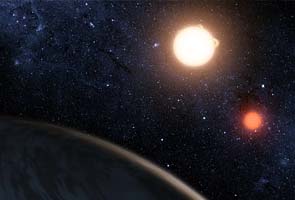California: Sometimes the
orange sun rises first. Sometimes it is the red one, although they are
never far apart in the sky and you can see them moving around each
other, casting double shadows across the firmament and periodically
crossing right in front of each other.
Such is life, if it were
possible, on the latest addition to the pantheon of weird planets now
known to exist outside the bounds of our own solar system. It is the
first planet, astronomers say, that has been definitely shown to be
orbiting two stars at once, circling the pair - which themselves orbit
each other tightly - at a distance of some 65 million miles.
A
team of astronomers using NASA's Kepler planet-hunting spacecraft
announced the discovery on Thursday in a paper published online in the
journal Science, in a talk at a conference in Jackson Hole, Wyoming, and
in a news conference at NASA's Ames Research Laboratory in Mountain
View, California, Kepler's headquarters.
The official name of
the new planet is Kepler 16b, but astronomers are already referring to
it informally as Tatooine, after the home planet of Luke and Anakin
Skywalker in the George Lucas Star Wars movies, which also had two suns.
"Reality has finally
caught up with science fiction," said Alan P. Boss of the Carnegie
Institution, a member of the research team.
Indeed, John Knoll,
who is a visual effects supervisor at Industrial Light & Magic,
which is part of Lucasfilm, and who worked on several of the Star Wars
movies, joined the Ames news conference and showed a clip from the
original movie.
"Again and again we see that the science is
stranger and weirder than fiction," Mr. Knoll said. "The very existence
of this discovery gives us cause to dream bigger."
While some
double-star systems, of which there are billions in the galaxy, have
been suspected to harbour planets, those smaller bodies have never been
seen.
"This is a direct detection; it removes all doubt," said
Laurance Doyle of the SETI Institute in Mountain View, California, who
led the discovery team.
Beyond the wow factor, astronomers said
the discovery - as so many discoveries of so-called exoplanets have done
- had thrown a wrench into another well-received theory of how planets
can and cannot form. "In other words," said Sara Seager, a planetary
expert at the Massachusetts Institute of Technology who was not part of
the discovery team, "people don't really know how to form this planet."
It
was long thought, Dr. Seager said, that for its orbit to be stable, a
planet belonging to two stars at once would have to be at least seven
times as far from the stars as the stars were from each other. According
to that, Kepler 16b would have to be twice as far out as it is to
survive.
"This planet broke the rule," she said.
Moreover,
by timing all the eclipses and transits of the planet and stars in the
system, the astronomers have been able to measure the sizes and masses
of the stars and the planet to unusually high precision, calibrating
models of stellar and planetary properties.
"I believe this is the best-measured planet outside the solar system," Dr. Doyle said.
Technically,
Tatooine is probably a ball of rock and gas about the size and density
of Saturn living in a system about 200 light-years away, in the
constellation Cygnus.
If you go, pack to wear layers. Because
those suns move back and forth all the time, temperatures on the planet
can change by 50 degrees or more over the course of a few Earth days,
from minus 100 to minus 150 Fahrenheit. So the weather is like "a nippy
day in Antarctica at best," as Dr. Doyle put it.
Kepler,
launched in 2009, is on a mission to determine the fraction of stars in
the galaxy that have Earth-like planets. It scrutinizes a patch of some
155,000 stars in the constellations Cygnus and Lyra looking for dips in
starlight when planets cross in front of their home stars.
In
the case of the Kepler 16 system - home to Tatooine - there turned out
to be a lot of dips. The two stars are about 20 million miles apart and
produce two eclipses every 41 days as they take turns going in front of
each other. One star is about two-thirds the mass of the Sun, the other
about a fifth of the Sun.
In addition, there are smaller dips
when the planet, which is about 65 million miles from the center of the
system - about the distance of Venus from the Sun - passes in front of
each of the stars in the course of its 229-day orbit.
The degree
of dimming during the planetary transits - those times that a planet
crosses the path of something else - usually allows Kepler astronomers
to measure the size of a planet relative to the stars. As a result,
uncertainties in the properties of stars propagate into uncertainties of
as much as 25 percent in the mass of a planet - enough to blur the line
between a rocky planet and a gaseous one.
But in the Kepler 16
system, by comparing slight variations in the timing of the transits
with calculations of the positions of the stars and the gravitational
nudges the bodies give one another, Dr. Doyle's team could deduce the
absolute masses and sizes of the stars and planets in the system. That
is a tool, they say, that is becoming increasingly valuable for
determining the masses of small planets in multiple-planet systems.
As a result, said Dr. Doyle, "it's a laboratory for all sorts of physics and stellar evolution."
The
Tatooine laboratory will be available to a wide audience for at least a
while longer. Dr. Doyle noted that amateur astronomers in northern
Asia, equipped with as little as an eight-inch telescope and an
off-the-shelf C.C.D. detector (an electronic device that cameras use to
capture images), would be able to record the passage of the Tatooine
planet across the brighter star in its system on June 28 next year.
But
enjoy it while you can. Because of variations in the planet's orbital
plane, as seen from Earth, the planet will stop crossing one of the
stars as soon as 2014 and cease transiting the other, brighter one in
2018. It will be around 2042 before the show starts up again for
Earthlings.










 Rahul
Dravid was in no mood to let England have it easy in the fifth ODI
which is also his last for India. A huge reception from the spectators
at Cardiff was reciprocated with a powerful fifty by the veteran
batsman.
Rahul
Dravid was in no mood to let England have it easy in the fifth ODI
which is also his last for India. A huge reception from the spectators
at Cardiff was reciprocated with a powerful fifty by the veteran
batsman. World
champions India have dropped to the fifth position in the Reliance ICC
ODI Championship table after England won the five-match ODI series 3-0
on Friday.
World
champions India have dropped to the fifth position in the Reliance ICC
ODI Championship table after England won the five-match ODI series 3-0
on Friday.